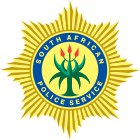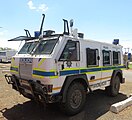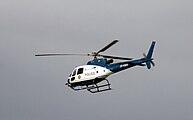South African Police Service
| South African Police Service | |
|---|---|
 South African Police Service badge | |
 South African Police Service flag | |
| Abbreviation | SAPS |
| Agency overview | |
| Formed | 1995 |
| Preceding agencies |
|
| Employees | 171,692 (2021/22) |
| Jurisdictional structure | |
| National agency | South Africa |
| Operations jurisdiction | South Africa |
| Size | 1,219,090 km2 |
| Population | 62,091,133 (2022 census) |
| Constituting instruments |
|
| General nature | |
| Operational structure | |
| Officers | 117,950 (2022/23) |
| Civilians | 52,792 (2019/20) |
| Minister of Police responsible | |
| Agency executive |
|
| Divisions | 6
|
| Provincials | 9
|
| Facilities | |
| Stations | 1,138 (2014/15) |
| Website | |
| www | |
| [1] | |
The South African Police Service (SAPS) is the national police force of the
The Constitution of South Africa lays down that the South African Police Service has a responsibility to prevent, combat and investigate crime, maintain public order, protect and secure the inhabitants of the Republic and their property, uphold and enforce the law, create a safe and secure environment for all people in South Africa, prevent anything that may threaten the safety or security of any community, investigate any crimes that threaten the safety or security of any community, ensure criminals are brought to justice and participate in efforts to address the causes of crime.[4]
Amnesty International and others have expressed serious concerns about South African police brutality, including torture and extrajudicial killings.[5][6][7]
History
Colonial years
The South African Police Service traces its origin to the Dutch Watch, a paramilitary organisation formed by settlers in the Cape Province in 1655 to protect civilians and to maintain law and order. In 1795, British officials assumed control over the Dutch Watch, and in 1825 established the Cape Constabulary (which became the Cape Town Police Force in 1840). In 1854, a police force was established in Durban which would become the Durban Borough Police, and in 1935 the Durban City Police (DCP).[8] Act 3 of 1855 established the Frontier Armed and Mounted Police Force in the Eastern Cape, restyled as the Cape Mounted Riflemen in 1878.[9]
1913-1994
The
When the National Party (NP) edged out its more liberal opponents in nationwide elections in 1948, the new government enacted legislation that strengthened the relationship between the police and the military. Police subsequently became heavily armed, especially when facing unruly or hostile crowds. The Police Act (No. 7) of 1958 broadened the mission of the SAP beyond conventional police functions, and allowed police to quell civil unrest and conduct counterinsurgency operations. The Police Amendment Act (No. 70) of 1965 allowed police to detain any person, receptacle, vehicle, aircraft, or premises within one mile of any national border, and to seize anything found without a warrant. This search-and-seize zone was extended to within eight miles of any border in 1979 and to the entire country in 1983.
Post-apartheid (1994–present)
The new Minister of Safety and Security, Sydney Mufamadi, obtained police training assistance from Zimbabwe, the United Kingdom, and Canada and proclaimed that racial tolerance and human rights would be central to police training in the future. By the end of 1995, the SAPS had incorporated the ten police agencies of the former homelands, and had reorganised at both national and provincial level.
The Investigative Psychology Unit (IPU), also referred to as Investigative Psychology Section (IPS), was founded by forensic psychologist Micki Pistorius[10] in 1996. Elmarie Myburgh was a founding member It was then a division of the Serious and Violent Crimes Unit, later being moved to the Detective Service, and from June 2008 to the Criminal Record and Forensic Science Service (CRFSS). At that time, it comprised only three members at national head office level, led by Gerard Labuschagne.[11]
Organisation

South African Police Service headquarters in located in Pretoria.
Divisions
As of March 2023[update], there were three Deputy National Commissioners, with each of these split into divisions as follows:[12]
- Policing:
- Visible Policing and Operations
- Protection and Security Services
- Crime Detection:
- Detective and Forensic Services
- Crime Intelligence
- Support Services
- Human Resource Management
- Human Resource Development
- Legal and Policy Services
- Technology Management Services
Rank structure
A new ranking system of the South African Police Service was adopted in April 2010.[13] The change caused some controversy as new ranks like "general" and "colonel" have a military connotation. Furthermore, the new rank system mirrors the system used by the South African Police during the apartheid era. In 2009, Deputy Minister of Police Fikile Mbalula spoke of making the police a paramilitary force by changing the SAPS ranking system so that it would closely mirror the military ranking system. This created a significant amount of controversy from people critical of what they called the "militarisation" of the police.[14][15][16]
The ranking system was amended in 2016. The role of regional police commissioner was introduced, with the rank of lieutenant general. The major and lieutenant ranks were eliminated, with lieutenants assuming the rank of captain and majors assuming the rank of lieutenant colonel.[17][18]
Current senior staff
As of 2024[update] the National Commissioner is Lt. Gen. Sehlahle Fannie Masemola,[19] who was appointed on 31 March 2022.[20][21] Leon Mbangwa is Chief of Staff.[22]
SAPS organisational profile
| Rank | Number of officers/employees |
|---|---|
| Ministerial personnel | 30 |
| National Commissioner (General) | 1 |
| Deputy National Commissioner (Lt. Gen.) | 4 |
| Div. Commissioners/National Head/Deputy Nat. Head, other top management (Lt. Gen.) | 12 |
| Provincial Commissioners (Lt. Gen.) | 9 |
| Major General | 156 |
| Brigadier | 623 |
| Colonel | 2,417 |
| Lieutenant Colonel | 5,975 |
| Captain | 12,155 |
| Non-commissioned officers | 123,896 |
| Public Service Act employees | 34,226 |
| Total employees | 179,502 |
| Group | Senior Management | |||
|---|---|---|---|---|
| Rank | General (Gen)
|
Lieutenant General (Lt Gen)
|
Major General (Maj Gen)
|
Brigadier |
| Role | Designation of National Commissioner |
Actg. National Commissioner, Deputy National Commissioner, Regional Commissioner, Provincial Commissioner, Divisional Commissioner | ||
| Insignia | 
|

|

|

|
| Group | Junior Management | |||
|---|---|---|---|---|
| Rank | Colonel (Col) | Lieutenant Colonel (Lt Col)
|
Captain | |
| Insignia | 
|

|

| |
| Group | Other Ranks | |||
|---|---|---|---|---|
| Rank | Warrant Officer (WO)
|
Sergeant (Sgt) | Constable (Const) | |
| Insignia | 
|

|

| |
Resources
Vehicles
Through the early-1990s, the police were equipped with smoke and tear-gas dispensing vehicles, tank trucks with water cannons, vehicles that dispensed barbed wire or razor wire to cordon off areas, and a number of rotor and fixed wing aircraft for surveillance, ground force management, rapid deployment of Task Force and specialist teams to crime scenes and VIP personnel movements. The RG-12 'Nyala' is on the most commonly used armoured vehicle of the service. The Casspir Mine-Resistant Ambush Protected Vehicle is another notable vehicle used by the police.[citation needed]
-
BMW 3 Series Highway Patrol
-
Volkswagen Golf GTi
-
Mercedes-Benz Vito Explosives Section
-
Pilatus PC-6/B2-H4
Aviation
As of October 2023[update], with the arrival of a new helicopter, the SAPS Air Wing operates a fleet of 34 aeroplanes and helicopters. The Air Wing has about 50 pilots and 300 other personnel.[25]
Fleet
The SAPS Air Wing fleet consists of:[26]
|
Airplanes
|
Helicopters
|
Firearms
South African Police Service officers generally carry a Vektor Z88 9mm
Criticism and controversies
Graphs are unavailable due to technical issues. There is more info on
Marikana Massacre (2012) and Zuma Riots (2021) are highlighted.[27] AdministrationSince the departure of democratic South Africa's first National commissioner George Fivaz in January 2000, a number of successive commissioners have been unable to complete a single term in office, most implicated in and charged with misconduct.[28][29] The distribution of personnel has been controversial, with local legislators questioning why areas most in need of policing resources are being neglected.[30] The department was criticised by the Western Cape Government for providing the lowest number personnel (adjusted for population) with a shortage of 2,392 officers,[31] despite having the highest murder rate.[32][33] This was the subject of the Khayelitsha Commission in 2012. Brutality and repressionIn 2011, 630 police officers from Gauteng Province were arrested for fraud and corruption, rape and murder.[51] An April 2012 editorial in The Times opined: "It seems torture and outright violation of human rights is becoming the order of the day for some of our police officers and experts warn that the line between criminals and our law enforcement officers is "blurred"."[52]
In February 2013, police in Daveyton, Gauteng were caught on video brutalising Mido Macia, a Mozambican taxi driver accused of parking illegally. Macia was handcuffed to a police van and dragged through the streets, later succumbing to his injuries.[53] Eight police officers were arrested and later convicted of murder.[54] Three police officers were arrested for the controversial shooting of Nathaniel Julies, a 16 year-old boy with down syndrome, in Eldorado Park.[citation needed ]
Marikana massacreThe Sharpeville Massacre of 1960, and has been referred to as a turning-point in post-1994 South Africa.[61][62][63]
CorruptionOn 10 September 2007 an arrest warrant was issued by the National Prosecuting Authority (NPA) for National Police Commissioner Mail and Guardian claim to have solid information supporting the widespread suspicion that President Mbeki suspended Pikoli as part of a bid to shield Police Commissioner Selebi.[64] According to the Mail and Guardian on 5 October 2007 the NPA was investigating Selebi for corruption, fraud, racketeering and defeating the ends of justice.[64]
Selebi was found guilty of corruption in July 2010, but not guilty of further charges of perverting the course of justice.[65]
In February 2011 Bheki Cele was implicated in unlawful conduct and maladministration with a R500m lease agreement for the new police headquarters in Pretoria.[66] In October 2011, President Jacob Zuma announced that Cele had been suspended pending an investigation into the agreement.[67] After recommendation from a board of inquiry, Zuma dismissed Cele and announced that Riah Phiyega, the first female commissioner, would replace him.[68] In February 2018, SAPS Lieutenant-General Khomotso Phahlane, who was also former acting SAPS Commissioner, and his wife appeared in court on charges of fraud and corruption.[69][70][71] On 30 July 2020, Phahlane was dismissed from the police after three years on suspension.[72] The same day, he was found guilty of dishonest conduct.[72] On 12 July 2019, it was announced the five North West Province police officers were arrested during the week in three separate corruption cases.[73] On 4 June 2020, six senior Gauteng police officers where among 14 people arrested on corruption charges.[74] Two other senior officers, now retired, were arrested as well.[75] Among the Guateng-based SAPS officers charged with corruption included three brigadiers and a retired SAPS Lieutenant General.[75] On 12 October 2020, Lieutenant-General Bonang Mgwenya, the country's second-most senior police official, was arrested on charges of corruption, fraud, theft and money laundering involving about R200-million and afterwards appeared in Ridge Magistrates court.[76] At the time of Mgwenya's arrest, she and Phahlane were among 14 fellow officers who were charged with corruption.[76] Mgwenya was suspended on 15 October 2020 and was dismissed from SAPS on 13 November 2020.[77] On 23 December 2020, four Cape Town police officers attached to the national border control unit at Cape Town International Airport were arrested for extorting money from Chinese businesses.[78] On 23 December 2020, Peter Ntsime, Acting Deputy General Secretary of the South African Policing Union (SAPU), reported that Colonel Kamelash Dalip Singh, a senior SAPU policeman from the KwaZulu-Natal Provincial Anti-Corruption Unit, was arrested, and then released on bail, on a bribe charge. Ntsime criticised the arrest, stating Singh was at the forefront of arresting crooked police officers and was onto a big syndicate. Directorate for Priority Crime Investigation (Hawks) spokesperson, Captain Simphiwe Mhlongo, said that undercover Hawks officers caught Singh red-handed accepting a R5,000 bribe.[79] On 28 December 2020, three law enforcement officers who were employed by the Emalahleni Municipality were arrested in Mpumalanga on corruption and bribery charges which involved allegations of not issuing standard fines to motorists who committed traffic violations, but instead extorting them for bribes.[80] In 2022, two criminal charges were lodged by the Independent Police Investigative Directorate against the National Police Commissioner Khehla Sitole for refusing to cooperate with its investigation into the murder of Charl Kinnear. Kinnear was a police intelligence officer investigating organised crime within the SAPS.[81] List of former National Commissioners
Battle honoursPolice units earned battle honours in both world wars and in border wars with Rhodesia. First World War
Second World War
Other
Notes
References
See also
External linksWikimedia Commons has media related to South African Police Service. |

![Ford Focus[24]](http://upload.wikimedia.org/wikipedia/commons/thumb/4/40/South_African_Police_K9_Ford_Focus_%2816973321327%29.jpg/184px-South_African_Police_K9_Ford_Focus_%2816973321327%29.jpg)







